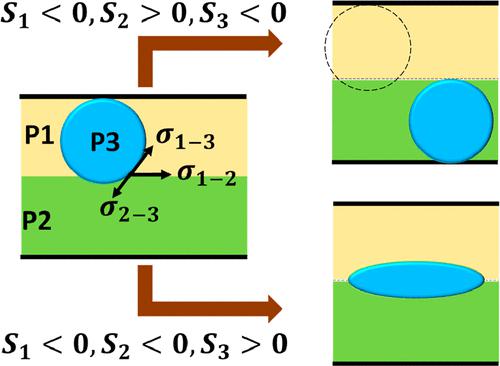Our official English website, www.x-mol.net, welcomes your
feedback! (Note: you will need to create a separate account there.)
Migration and Spreading of Droplets across a Fluid–Fluid Interface in Microfluidic Coflow
Langmuir ( IF 3.7 ) Pub Date : 2022-07-25 , DOI: 10.1021/acs.langmuir.2c01260 Shamik Hazra 1 , Sushanta Mitra 2 , Ashis Kumar Sen 1, 3
Langmuir ( IF 3.7 ) Pub Date : 2022-07-25 , DOI: 10.1021/acs.langmuir.2c01260 Shamik Hazra 1 , Sushanta Mitra 2 , Ashis Kumar Sen 1, 3
Affiliation

|
Interfacial migration of droplets in microfluidic confinements has significant relevance in cell biology and biochemical assays. So far, studies on passive interfacial migration of droplets are limited to co-flow interfaces having small interfacial tension (IFT ∼ 1 mN/m). Here, we elucidate the migration and spreading of droplets (SiO-1000, SiO-100, FC40, and castor oil as phase 3, P3) across the interface between a pair of coflowing streams (PEG as P1, SiO-100, SiO-20, FC40, and olive oil as P2) having large IFT (∼10 mN/m), with the three different phases immiscible. Interfacial migration involving interfaces of large IFT is facilitated by confining droplets between the channel wall and coflow interface. We find that contact between droplets and the coflow interface is governed by the confinement ratio (i.e., the ratio of drop size to stream width) and the ratio of the capillary numbers of the coflowing streams. Depending on the sign of the spreading parameter (S) of the co-flowing phases, droplet migration or spreading at the interface is observed. While interfacial migration is observed for S1 < 0 and S2 > 0, droplet spreading is observed for S1 < 0 and S2 < 0, where S1 and S2 are P1 and P2 side spreading parameters, respectively. We investigate the droplet migration dynamics and time evolution of the contact line and the interface. Our results show that the speed of interfacial migration increases with increasing spreading parameter contrast between the coflowing phases. In the droplet spreading case, we experimentally study the variation in the spreading length with time, revealing three distinct regimes in good agreement with predictions from analytical scaling. Our study explores the interfacial transport of droplets involving high IFT interfaces, advancing the fundamental understanding of the topic that may find relevance in droplet microfluidics.
中文翻译:

微流体 Coflow 中液滴在流体-流体界面上的迁移和扩散
微流体限制中液滴的界面迁移在细胞生物学和生化测定中具有重要意义。到目前为止,关于液滴被动界面迁移的研究仅限于具有小界面张力(IFT ∼ 1 mN/m)的共流界面。在这里,我们阐明了液滴(SiO-1000、SiO-100、FC40 和蓖麻油作为相 3,P3)在一对共流流(PEG 作为 P1、SiO-100、SiO- 20、FC40 和橄榄油作为 P2)具有较大的 IFT(~10 mN/m),三个不同的相不混溶。通过限制通道壁和共流界面之间的液滴,促进了涉及大型 IFT 界面的界面迁移。我们发现液滴和共流界面之间的接触受限制比(即,液滴大小与流宽的比值)和共流流的毛细管数比。取决于扩展参数的符号 (观察到共流相的S )、液滴迁移或在界面处的扩散。虽然S 1 < 0 和S 2 > 0观察到界面迁移,但S 1 < 0和S 2 < 0观察到液滴扩散,其中S 1和S 2分别是 P1 和 P2 侧扩展参数。我们研究了接触线和界面的液滴迁移动力学和时间演变。我们的结果表明,界面迁移的速度随着共流相之间扩散参数对比度的增加而增加。在液滴扩散的情况下,我们通过实验研究了扩散长度随时间的变化,揭示了三种不同的状态,与分析尺度的预测非常吻合。我们的研究探索了涉及高 IFT 界面的液滴的界面传输,促进了对可能与液滴微流体相关的主题的基本理解。
更新日期:2022-07-25
中文翻译:

微流体 Coflow 中液滴在流体-流体界面上的迁移和扩散
微流体限制中液滴的界面迁移在细胞生物学和生化测定中具有重要意义。到目前为止,关于液滴被动界面迁移的研究仅限于具有小界面张力(IFT ∼ 1 mN/m)的共流界面。在这里,我们阐明了液滴(SiO-1000、SiO-100、FC40 和蓖麻油作为相 3,P3)在一对共流流(PEG 作为 P1、SiO-100、SiO- 20、FC40 和橄榄油作为 P2)具有较大的 IFT(~10 mN/m),三个不同的相不混溶。通过限制通道壁和共流界面之间的液滴,促进了涉及大型 IFT 界面的界面迁移。我们发现液滴和共流界面之间的接触受限制比(即,液滴大小与流宽的比值)和共流流的毛细管数比。取决于扩展参数的符号 (观察到共流相的S )、液滴迁移或在界面处的扩散。虽然S 1 < 0 和S 2 > 0观察到界面迁移,但S 1 < 0和S 2 < 0观察到液滴扩散,其中S 1和S 2分别是 P1 和 P2 侧扩展参数。我们研究了接触线和界面的液滴迁移动力学和时间演变。我们的结果表明,界面迁移的速度随着共流相之间扩散参数对比度的增加而增加。在液滴扩散的情况下,我们通过实验研究了扩散长度随时间的变化,揭示了三种不同的状态,与分析尺度的预测非常吻合。我们的研究探索了涉及高 IFT 界面的液滴的界面传输,促进了对可能与液滴微流体相关的主题的基本理解。











































 京公网安备 11010802027423号
京公网安备 11010802027423号